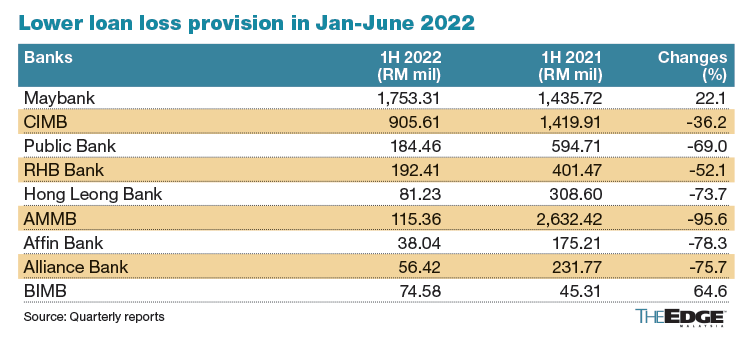
KUALA LUMPUR (Sept 2): Banks' provisions in the first half of the year (1H2022) has been widely watched as it is seen as a precursor to a full normalisation of loan repayment with various assistance programmes winding down coupled with the reopening of the economy and international borders.
Although certain banks are still providing their own repayment assistance on a case-by-case basis, application for the government’s Financial Management and Resilience Programme (URUS) had closed by the end of March.
Analysts that theedgemarkets.com spoke to generally believe that banks' provisions should be tapering off from the pandemic high. While there is a possibility of an uptick going into 2H2022 given the uncertain macroeconomic conditions and higher interest rate environment, the quantum is unlikely to be significant.
“The banks have presented full-year guidance that provisions may pick up in 2H2022 versus 1H2022, but I reckon that it is just them being prudent against global and supply chain uncertainties,” said Kenanga Research analyst Clement Chua.
“With all else being equal, I won’t be surprised if 2H2022 provisions could be better than 1H on the back of a more vibrant economy,” he added.
Hong Leong Investment Bank analyst Chan Jit Hoong also said the current provisioning in the banking industry seems sufficient and does not expect a significant spike in 2H2022.
“Provisions were kind of mixed in 1H2022 by banks. In general, provisioning level is sufficient, and even if there are top ups in 2H2022, it won’t be much,” he said.
Among the nine local public-listed banks, only two — Malayan Banking Bhd (Maybank) and Bank Islam Malaysia Bhd (BIMB) — have seen an increase in provisions in 1H2022, while expected credit losses for the rest of the lenders declined 36% to as much as 96% in the first six months of this year.
Maybank’s group president and chief executive officer Datuk Khairussaleh Ramli said in a media briefing last week that the increase is supposed to be one-off for the oil and gas as well as hospitality segments.
The largest banking group in Malaysia by asset size saw its provisions rise 22% to RM1.75 billion in 1H2022 from RM1.44 billion in the previous corresponding period.
BIMB, on the other hand, saw provisions climb by 65% to RM74.58 million in 1HFY2022 from RM45.31 million in 1HFY2021. The Islamic banking group cautioned in its quarterly report that “rising inflationary pressure can potentially threaten the group’s provisions on financing as it affects the debt servicing capability of consumers and businesses.”
Nonetheless, borrowing costs are expected to remain “manageable” and may not lead to a significant deterioration in lenders’ asset quality even with higher overnight policy rate (OPR) in 2H2022, said a banking analyst who declined to be named.
“Even with another 50bps OPR hike in September and November, it will be still lower than the pre-pandemic 3.25%, I won’t say it is not a concern, but it should be manageable, unless there is a major event,” he said.
“The increase in provisions by Maybank and BIMB is probably due to specific accounts or industries, and probably not a reflection that overall asset quality is at risk,” he added.
CGS-CIMB’s analyst Winson Ng noted that the banking industry’s total provisions fell RM40.7 million month-on-month in July to RM35.2 billion, and sees signs of potential write-backs by certain banks.
“This could indicate some chunky write-backs by certain banks and could be an early indicator of loan loss provisioning in 3Q 2022 remaining low,” he said in a note on Tuesday (Aug 31).
Having said that, it is worth noting that RHB Bank Bhd, whose provisions declined 52% to RM192.41 million in 1H2022 from RM401.47 million, said its provisions may experience an “uptake” in 2H2022 as the gross impaired loan (GIL) ratio for its small and medium enterprise (SME) customers is trending upwards.
As OPR hikes seem imminent at Bank Negara Malaysia's upcoming Monetary Policy Committee’s meetings amid rising inflationary pressure, banks provisions would remain closely watched going forward even with repeated assurances from the industry and central bank that the sector’s capital and liquidity buffers are resilient.

